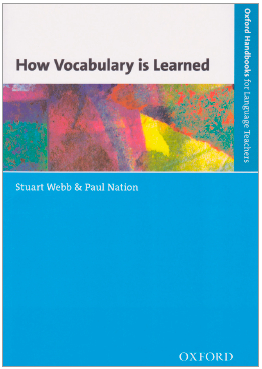How Vocabulary is Learned
How Vocabulary is Learned
by Stuart Webb and Paul Nation
OUP 2017 978-0-19-440355-9

A key element of any language course is helping the learners to develop vocabulary knowledge, so they can operate effectively in English. Knowing this truism is one thing, realising it in practice is something else entirely. How Vocabulary is Learned by Stuart Webb and Paul Nation can help us help our learners. It is that rare thing, a book that provides accessible theory and discussion of research findings, while also exploring practical applications. It gives equal focus to the why and the how and, as such, is a must buy.
The volume starts by arguing that some words are more important to learners that others, an argument that has foundations in lexical coverage. Such coverage figures have allowed researchers to create word lists that, although seemingly out of fashion, still absolutely have a place in the language classroom. As well as introducing the most up-to-date lists, Webb and Nation discuss the pros and cons of various lists. This helps readers effectively judge whether a particular list is appropriate for their specific context. Further chapters deal with learning burden, the incremental nature of lexical development, and conditions that facilitate learning. Some readers might be familiar with research in these areas, but take it from me, there will be something new for most. For example, while other books have dealt with extensive reading, the additional focus on viewing here is particularly welcome, as this is a major avenue of current research and reflects typical learner behaviour. We know many of our learners like watching videos, but now we can set up such learning opportunities to transform journeys down even the deepest YouTube
black hole into an educationally valuable experience.
As teachers, we want to provide our learners with the best advice and effective learning tasks. The discussion on analysing vocabulary learning activities will challenge us to consider the extent to which we currently do this. Most welcome is that, rather than merely listing effective activities, the rationale for each provides a model against which readers can apply a similarly robust analysis of the activities they currently use. Thus, readers can generalise the principles exampled in this book to their own context, which is likely to have significant practical benefits.
Discussions of best practice seem to go hand in hand with colleagues claiming ‘but it wouldn’t work in my context’. Thankfully, Webb and Nation saw this coming! They have prepared evidenced advice on best practice for a range of contexts: EFL, ESL, young learners, large classes, beginners, advanced learners, intensive courses, and more besides. We know that consideration of context is vital to the success of any pedagogical intervention, and readers will be able to incorporate the nuggets gained from this book into their classes, irrespective of the particular context in which they work. This includes both classroom-based tasks to foster lexical development, as well as strategy work to facilitate sustainable learning. This is a vital area to consider if we want our learners to be independent, autonomous, life-long students.
Webb and Nation, who have years of teaching experience between them, understand the questions that many practitioners have: Should I use L1 in the classroom? How can I utilise corpora to enhance learning? etc. This book is formed from and around those questions and, as such, strikes at the heart of the issues we find most pressing. Overall, this book covers key areas related to vocabulary learning and teaching. It presents findings and research-based advice in an accessible manner. As a result, it is a valuable professional development tool, either for an individual who wants a better foundation in this important area, or as the centre of an institutional development programme. It will make an important addition to our bookshelves and is a must for any conscientious teacher.
Sam Barclay Nottingham, UK
Comments
Write a Comment
Comment Submitted